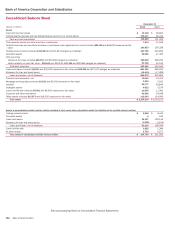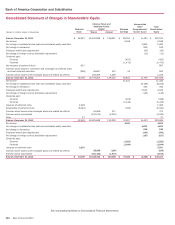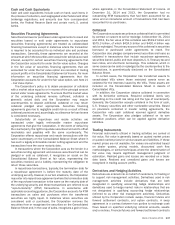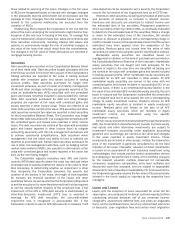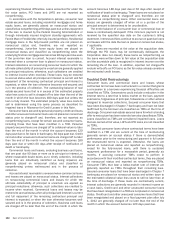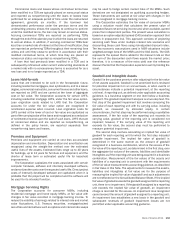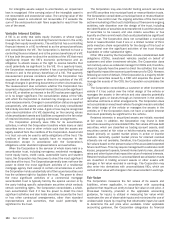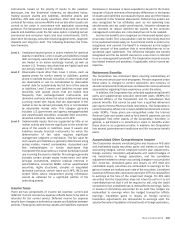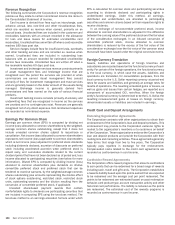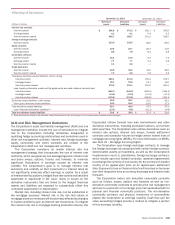Bank of America 2014 Annual Report Download - page 151
Download and view the complete annual report
Please find page 151 of the 2014 Bank of America annual report below. You can navigate through the pages in the report by either clicking on the pages listed below, or by using the keyword search tool below to find specific information within the annual report.Bank of America 2014 149
flows related to servicing of the loans. Changes in the fair value
of IRLCs are recognized based on interest rate changes, changes
in the probability that the commitment will be exercised and the
passage of time. Changes from the expected future cash flows
related to the customer relationship are excluded from the
valuation of IRLCs.
Outstanding IRLCs expose the Corporation to the risk that the
price of the loans underlying the commitments might decline from
inception of the rate lock to funding of the loan. To manage this
risk, the Corporation utilizes forward loan sales commitments and
other derivative instruments, including interest rate swaps and
options, to economically hedge the risk of potential changes in
the value of the loans that would result from the commitments.
The changes in the fair value of these derivatives are recorded in
mortgage banking income.
Securities
Debt securities are recorded on the Consolidated Balance Sheet
as of their trade date. Debt securities bought principally with the
intent to buy and sell in the short term as part of the Corporation’s
trading activities are reported at fair value in trading account
assets with unrealized gains and losses included in trading
account profits. Debt securities purchased for longer term
investment purposes, as part of asset and liability management
(ALM) and other strategic activities are generally reported at fair
value as available-for-sale (AFS) securities with net unrealized
gains and losses net-of-tax included in accumulated OCI. Certain
other debt securities purchased for ALM and other strategic
purposes are reported at fair value with unrealized gains and
losses reported in other income (loss). These are referred to as
other debt securities carried at fair value. AFS securities and other
debt securities carried at fair value are reported in debt securities
on the Consolidated Balance Sheet. The Corporation may hedge
these other debt securities with risk management derivatives with
the unrealized gains and losses also reported in other income
(loss). The debt securities are carried at fair value with unrealized
gains and losses reported in other income (loss) to mitigate
accounting asymmetry with the risk management derivatives and
to achieve operational simplifications. Debt securities which
management has the intent and ability to hold to maturity are
reported at amortized cost. Certain debt securities purchased for
use in other risk management activities, such as hedging certain
market risks related to MSRs, are reported in other assets at fair
value with unrealized gains and losses reported in the same line
item as the item being hedged.
The Corporation regularly evaluates each AFS and held-to-
maturity (HTM) debt security where the value has declined below
amortized cost to assess whether the decline in fair value is other
than temporary. In determining whether an impairment is other
than temporary, the Corporation considers the severity and
duration of the decline in fair value, the length of time expected
for recovery, the financial condition of the issuer, and other
qualitative factors, as well as whether the Corporation either plans
to sell the security or it is more-likely-than-not that it will be required
to sell the security before recovery of the amortized cost. If the
impairment of the AFS or HTM debt security is credit-related, an
other-than-temporary impairment (OTTI) loss is recorded in
earnings. For AFS debt securities, the non-credit-related
impairment loss is recognized in accumulated OCI. If the
Corporation intends to sell an AFS debt security or believes it will
more-likely-than-not be required to sell a security, the Corporation
records the full amount of the impairment loss as an OTTI loss.
Interest on debt securities, including amortization of premiums
and accretion of discounts, is included in interest income.
Premiums and discounts are amortized to interest income over
the estimated lives of the securities. Prepayment experience,
which is primarily driven by interest rates, is continually evaluated
to determine the estimated lives of the securities. When a change
is made to the estimated lives of the securities, the related
premium or discount is adjusted, with a corresponding charge or
credit to interest income, to the appropriate amount had the current
estimated lives been applied since the acquisition of the
securities. Realized gains and losses from the sales of debt
securities are determined using the specific identification method.
Marketable equity securities are classified based on
management’s intention on the date of purchase and recorded on
the Consolidated Balance Sheet as of the trade date. Marketable
equity securities that are bought and held principally for the
purpose of resale in the near term are classified as trading and
are carried at fair value with unrealized gains and losses included
in trading account profits. Other marketable equity securities are
accounted for as AFS and classified in other assets. All AFS
marketable equity securities are carried at fair value with net
unrealized gains and losses included in accumulated OCI on an
after-tax basis. If there is an other-than-temporary decline in the
fair value of any individual AFS marketable equity security, the cost
basis is reduced and the Corporation reclassifies the associated
net unrealized loss out of accumulated OCI with a corresponding
charge to equity investment income. Dividend income on AFS
marketable equity securities is included in equity investment
income. Realized gains and losses on the sale of all AFS
marketable equity securities, which are recorded in equity
investment income, are determined using the specific
identification method.
Certain equity investments held by Global Principal Investments
(GPI), the Corporation’s diversified equity investor in private equity,
real estate and other alternative investments, are subject to
investment company accounting under applicable accounting
guidance and, accordingly, are carried at fair value with changes
in fair value reported in equity investment income. These
investments are included in other assets. Initially, the transaction
price of the investment is generally considered to be the best
indicator of fair value. Thereafter, valuation of direct investments
is based on an assessment of each individual investment using
methodologies that include publicly-traded comparables derived
by multiplying a key performance metric of the portfolio company
by the relevant valuation multiple observed for comparable
companies, acquisition comparables, entry level multiples and
discounted cash flow analyses, and are subject to appropriate
discounts for lack of liquidity or marketability. For fund investments,
the Corporation generally records the fair value of its proportionate
interest in the fund’s capital as reported by the respective fund
managers.
Loans and Leases
Loans, with the exception of loans accounted for under the fair
value option, are measured at historical cost and reported at their
outstanding principal balances net of any unearned income,
charge-offs, unamortized deferred fees and costs on originated
loans, and for purchased loans, net of any unamortized premiums
or discounts. Loan origination fees and certain direct origination





